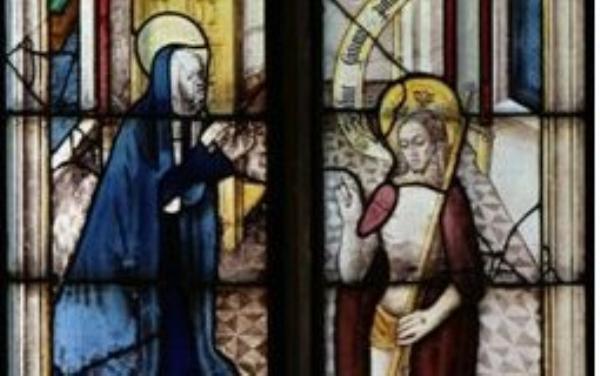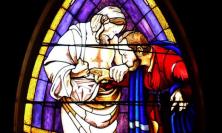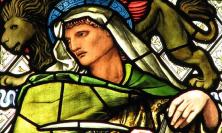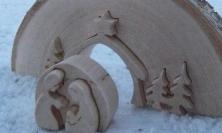The Church’s celebration of Christmas continues with the Feast of the Holy Family, which this year falls on 30 December. Jack Mahoney marks the occasion by contemplating the relationship between Jesus and his mother as it is expressed in an intriguing yet non-biblical tradition, a tradition which also has an important place in the Spiritual Exercises of St Ignatius. Might Our Lady have been the first person to see Christ after his resurrection?
Some weeks ago I was in the Cotswolds attending the funeral of an old friend and as I was driving back to London I decided to call in at Fairford, a lovely village in Gloucestershire which has a famous fifteenth-century church. As well as being a fine, late Perpendicular specimen of the ‘wool’ church, one built by a wealthy wool merchant to ensure his eternal salvation, the Fairford church of Saint Mary contains the finest set of original stained glass windows in England, dating from the late Middle Ages.
I had last visited it some fifty years ago as a Jesuit student and an enthusiast of pre-reformation churches, when I had been delighted to find in a heavenly orchestra which was spread across the tops of several windows the figure of an angel playing the bagpipes. As a Scot, I was so taken with this celestial sign of good taste that I wrote a letter to Fr James Moffat SJ, editor of the now defunct, Edinburgh-based Mercat Cross, drawing his readers’ attention to the heavenly piper at Fairford, although I could not refrain from adding as a comment on his music, with Keats, that, ‘heard melodies are sweet, but those unheard are sweeter’!
A surprising appearance
On this return to Fairford, as I browsed around the church’s windows I was astonished to come across one showing the risen Christ appearing to his mother. This is a theme with which I am now very familiar from my experience of St Ignatius’s Spiritual Exercises, in which he makes Jesus’s appearance to his mother his first after the resurrection, but it was an event to which I certainly had not expected to find mediaeval testimony.[1] The Fairford church’s windows, like those of many other mediaeval churches, served an unlettered laity as ‘the people’s illustrated bible’, educating them in their faith, from the creation of Adam and Eve through to the threatening west ‘doom’ window of the Last Judgement. This particular window, then, showing Jesus’s appearance to his mother after his resurrection, was evidence of a well-established tradition of the event, even though it does not appear anywhere in the New Testament descriptions of the appearances of the risen Jesus. I was interested to note that this window did not appear in the Lady Chapel on the north side of the chancel, which depicted Our Lady’s life and assumption, but in the southern, Corpus Christi chapel, among the mysteries surrounding the life and death of her son. Perhaps it was given further special significance by being depicted in this church which is specifically dedicated to his mother, Saint Mary. In my usual way, I thereupon started on a quest to find the history of this discovery, which I had found so surprising. There was quite a bit of evidence to unearth, although it took some ferreting out!
For instance, it was not long before I found in a local guidebook an explanation that the tradition of the risen Jesus appearing to his mother had a long history, and appeared as early as in the writings of St Ambrose in the fourth century. I further discovered that the Ignatian expert,Philip Endean SJ, in an article in The Way, identified Ludolf of Saxony’s Vita Christi (‘Life of Christ’) as a source of the tradition of the risen Jesus appearing to his mother, a source which was known to Ignatius and was used by him when writing his Spiritual Exercises.[2] I eventually tracked this down in the British Library, in the hope of finding in it a mention of Ambrose, and true enough Ludolf did give a reference to Ambrose. Unfortunately it was not quite accurate, and correcting it took further research.
We know that during his convalescence from operations following his battle injury at Pamplona, the bored Ignatius had access to Ludolf’s four-volume ‘Life of Christ’ and in this the Cistercian writer devoted a whole chapter to enquiring, ‘How the Lord Jesus appeared to his Mother’.[3] He describes how the women going to the tomb to anoint the body of Jesus did so with his mother’s permission.[4] He later observed that it seemed surprising that Mary did not go with the women. Repeating Augustine, he suggested as possible reasons for this that it would have been too much for her and that out of concern for her, John, to whom she had been entrusted by Jesus, would not permit her to go, adding finally that ‘the blessed Virgin knew that he was not there, but had risen immortal and incorruptible’. For ‘while our Lady was praying and gently weeping, suddenly the Lord Jesus came’ and appeared to his mother. She embraced him, ‘her mourning transformed into happiness’, and sharing their joy they sat and conversed about what had happened to him and what he had been doing since, while she reassured herself that his sufferings were really over.[5] It was true, Ludolf continued, that the gospel said nothing about this appearance of Jesus to his mother before anyone else, but it was fitting and was a pious belief more fully described in ‘a certain legend about the resurrection’. Moreover, the Roman Church celebrated it by a station at St Mary Major’s, and Ambrose himself gave witness to it.[6] Finally, Ludolf observed, unlike Jesus’s other Easter appearances, which were aimed at proving his resurrection from the dead, ‘he appeared first of all to his Virgin Mother, not to prove his resurrection but to delight her at the sight of him’.[7]
The former Superior General of the Society of Jesus, Fr Peter-Hans Kolvenbach, drew on his wide experience of the Eastern Church to trace Coptic, Byzantine and other Oriental sources of the tradition that Jesus’s first resurrection appearance was to his mother.[8] However, the first Western reference to Jesus appearing first to his mother does appear to be St Ambrose, as cited by Ludolf. Ambrose is writing a treatise on the excellence of virginity and he suggests that it confers a special integrity of faith: ‘consider that virgins merited seeing the resurrection of the Lord before the apostles’.[9] He seems implausibly to imply here that all the women who visited the tomb on the Sunday morning were virgins;[10] but he goes on then to contrast the Virgin Mary with Mary Magdalene when he notes that, ‘Mary saw the resurrection of the Lord; she was the first to see and believe. Mary Magdalene also saw, but she hesitated’.[11] It could be that Ambrose was also introducing a distinction between Mary’s faith and the Magdalene’s doubt to reconcile the non-biblical tradition of Jesus’s first appearing to his mother with the statement in Mk 16:9 that Jesus ‘first appeared to Mary Magdalene.’
Among the holy places
While recognising the influence on Ignatius of Ludolf of Saxony’s Life of Christ, Fr Kolvenbach also noted that this was not Ignatius’s only source for considering that Jesus’s first risen appearance was to his mother. In the course of his early, post-conversion pilgrimage to the Holy Land, Ignatius would have been aware of the standard itinerary of pilgrims to Jerusalem which included a visit to the chapel of Our Lady, ‘where Jesus first appeared to her after rising from the dead, as is piously believed.’ This, Kolvenbach noted, was described in pilgrim guidebooks in the fifteenth century and he thought it very likely that Ignatius himself had visited the church of the Lord’s appearance to his mother.[12] I suggest confirmation of this may come from Ignatius’s dictated autobiography, which describes how, ‘it was his firm determination to remain in Jerusalem, perpetually visiting the holy places’, although later he realised that ‘it was not God’s will that he remain there in those holy places’.[13]
Further evidence of Ignatius being personally familiar with the appearance of the risen Lord to his mother through the church in Jerusalem devoted to the event, we find the English chaplain of the pilgrim Sir Richard Guylforde describing in 1506 a chapel of Our Lady in Jerusalem as ‘the very self place where our Saviour Christ, after His Resurrection, first appeared unto His Blessed Mother, and said, Salve Sancta Parens [hail, holy Mother]’.[14] Apparently continuing the tradition to the present, it is still a regular event in Spain that at Easter two processions are formed, one of the risen Jesus, and the other of his Mother, which meet in front of the church to commemorate their meeting on the first Easter Sunday.[15]
Hail, holy Mother
As can be seen in the above illustration, the mediaeval window at Fairford which depicts this scene is intriguing in the details it portrays, which seem to correspond to the description given by Ignatius. Ludolf described Mary as seated at home when Jesus appeared to her, and rising at the sight of her son. Ignatius, in introducing the first contemplation of the Fourth Week of the Exercises, instructs the retreatant to envisage, ‘the house where our Lady was, studying it in detail, her room, the oratory, and the rest’.[16] In the Fairford window, the forefront shows the risen Christ with his wounds and, traditionally, holding a tiny cross, to show that he had overcome it, with his hand raised to indicate he is speaking. Looking at him in wonder is his mother, an elderly, frail figure robed in traditional blue and joining her hands in awe. Behind her one can identify what appear to be the entrance to a bedroom with a glimpse of the bed, and a space which could be an oratory with a lectern and book facing the window.
What I find fascinating in the window is the scroll which comes from the mouth of the risen Christ containing the salutation, Salve, Sancta parens – ‘Hail, holy mother’. These words, which open the traditional Introit verse of the Common Mass of the Blessed Virgin Mary, put beyond any possible doubt the fact that Jesus is here appearing to his mother, despite the silence on this in the gospels (and Ignatius tells us to use our common sense here[17]). In addition, the greeting of the risen Jesus in Fairford, ‘Salve, sancta parens’, actually repeats the one in the Jerusalem church as recorded by the chaplain to Sir Richard Guylforde, mentioned above. Is it fanciful to conjecture that our wealthy Cotswold wool merchant who endowed the splendid Fairford church brought back the scene and this detail from his own pilgrimage to Jerusalem, even a pilgrimage possibly imposed as part of his penance for the remission of his sins?[18]
One can theologise in many ways on the tradition of the first appearance of the risen Christ being to his mother, as taken up and highlighted by St Ignatius in the Spiritual Exercises. The French Jesuit, Jean-Claude Guy, sees the appearance of the risen Jesus to his mother in the Spiritual Exercises as a parallel for Ignatius of the earlier Annunciation to Mary, since each event expresses the divine action of salvation history taking place through Mary, both Christ’s coming from the blessed Trinity to earth and his returning from the grave to the Father.[19] Other commentators suggest that this first meeting between the risen Jesus and his mother points to her as representing the Church, so that it is in her that the resurrection is announced to the rest of the body of the faithful. Fr Kolvenbach recalls how in the fifth century, Sedulius saw Mary here as representing the Church, the new people of God, to whom Christ announces his resurrection, and observes that ‘Our Lady is the ecclesial focal-point where the passage of our sinful humanity to the new humanity of the risen Christ takes place’.[20] A similar point linking the mother of Jesus with the nascent Church is made by Belgian Jesuit, Simon Decloux, when he asks, ‘how can Mary give the Church birth to faith if she herself is not the very first one to whom the risen Son shows himself?’[21] Endean takes a different approach when he links the appearance of Jesus to ‘the role of Mary, “Our Lady”, in the Exercises as a whole,’ and suggests that ‘perhaps the graces Ignatius seems to expect from the Fourth Week at least allow, and might even require, retrojective expression in terms of a resurrection appearance to Christ’s mother’.[22]
Attractive as these theological and spiritual interpretations may very well be, they should not be allowed, I feel, to eclipse the simple emotional delight of Mary – and her Son – at their reunion after each has suffered so much. It is impossible, even presumptuous, to surmise what went through Mary’s mind at the unexpected appearance of her son returned from the dead: I wonder if at the sight of him she quietly breathed, ‘Of course’, as she was divinely inspired to realise why it was that her beloved son had been led to suffer so much and been brought back to life. However one may choose to interpret it, surely nothing can be allowed to detract from the intimate family relationship evident in the simple scene of son and mother set forth in the window of Fairford village church to elicit the faithful’s admiration and relief, as well as their sheer delight that the first person the risen Jesus would wish to console and reassure would naturally be his mother, ‘the handmaid of the Lord’ who had borne him. After all, the grace which Ignatius thought appropriate to pray for in contemplating the appearances of the risen Christ was ‘the grace to be filled with joy and happiness at the thought of Christ Our Lord’s great glory and happiness’, surely an experience to be shared first of all with his beloved mother.[23]
Jack Mahoney SJ is Emeritus Professor of Moral and Social Theology in the University of London and a former Principal of Heythrop College. His latest book, Christianity in Evolution: An Exploration, has recently been published by Georgetown University Press, Washington, D.C.
[1] St Ignatius, Spiritual Exercises, nos. 218-224, 299.
[2] P. Endean, ‘Our Lady’ and the graces of the Fourth Week, The Way, Supplement 99 (Autumn 2000), 44-60.
[3] Ludolf of Saxony, Vita Christi, part 2, chapter 70; Salzburg Universität: Institut für Anglistik und Amerikanistik, 2006, vol. 4, pp. 698-700.
[4] Ludolf, p. 698.
[5] Ludolf, pp. 699-700.
[6] Ludolf cites Ambrose de virginibus book 3, but in modern editions the passage is in de virginitate, 3; Migne PL 16, 270.
[7] Ludolf, p. 700.
[8] Peter-Hans Kolvenbach, The Easter Experience of Our Lady, in Our Lady and Christian Spirituality, CIS (Centrum Ignatianum Spiritualitatis), Rome, 1988, no. 58-59, vol XIX, 2-3, Appendix, pp 145-63 at 148-53.
[9] Ambrose, de virginitate, 3; Migne PL 16, 269.
[10] Mt 28:1 refers to Mary Magdalene and another Mary, but Mk 16:1 identifies them as Mary Magdalene and ‘Mary the mother of James and Salome.’
[11] Op. cit. PL 16, 270.
[12] Kolvenbach, 148.
[13] St. Ignatius’ Own Story, trans. W. J. Young (Loyola University Press, 1956), 45, 47; pp. 32, 33-4.
[14] Quoted in J. Brodrick, Saint Ignatius Loyola. The Pilgrim Years, London, Burns & Oates, 1956, 140. Other more or less contemporary pilgrim references are given by Endean, n. 2, pp. 57-58.
[15] Kolvenbach, 148.
[16] Spiritual Exercises, 220.
[17] Spiritual Exercises, 299.
[18] Being sent on pilgrimage was a not uncommon penance in the Middle Ages. See J. Mahoney, The Making of Moral Theology. A Study of the Roman Catholic Tradition (Oxford, Clarendon, 1989) pp. 11-13.
[19] Jean-Claude Guy, ‘L’apparition à Notre Dame’, Christus 95 (1977), 357-8. Guy also refers to the 14-15th century ‘sort of Michelin’ pilgrim guides, which very often refer to the appearance to Our Lady, and provides citations, p. 360.
[20] Kolvenbach, 161-2.
[21] S. Decloux, ‘Our Lady in Ignatian Spirituality’, CIS, XIX, 1988, 143.
[22] Endean, 46. See also 50-51.
[23] Spiritual Exercises, 221.






